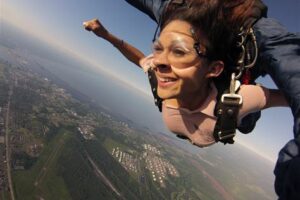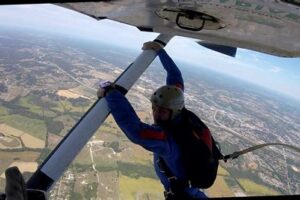Table of Contents
The fatality rate of skydiving refers to the percentage of deaths per number of jumps or participants in the sport. This metadescription explores the risks associated with skydiving and provides insight into the safety measures undertaken to minimize fatalities.
Skydiving, an exhilarating activity that allows individuals to experience the freedom of flight, has long captivated adventure seekers from around the world. However, amidst its thrill and adrenaline rush, there is an undeniable concern regarding the fatality rate associated with this extreme sport. Transitioning from the safety of solid ground to the vastness of the sky, one may wonder: just how dangerous is skydiving? Delving into the statistics, it becomes apparent that understanding the fatality rate of skydiving is crucial for anyone considering taking the plunge into this daring endeavor.
The Thrill of Skydiving
Skydiving is an extreme sport that has gained immense popularity over the years. It involves jumping from an aircraft at a high altitude and experiencing the exhilarating feeling of freefall before deploying a parachute to slow down and land safely on the ground. The adrenaline rush and sense of freedom associated with skydiving attract thrill-seekers from all corners of the globe. However, like any adventure sport, skydiving carries certain risks, including the potential for fatal accidents. In this article, we will explore the fatality rate of skydiving and provide insights into the safety measures in place to mitigate these risks.
The Statistics
When it comes to evaluating the fatality rate of skydiving, it is essential to consider the numbers within the larger context of the sport’s popularity. According to the United States Parachute Association (USPA), there were approximately 3.3 million jumps made in the US alone in 2019. Out of those jumps, there were 15 fatal skydiving accidents, resulting in a fatality rate of 0.0004%. While any loss of life is tragic, these statistics indicate that skydiving is relatively safe when compared to other activities.
The Importance of Training
One of the primary reasons for the relatively low fatality rate in skydiving is the extensive training that participants undergo. Before making their first solo jump, aspiring skydivers must complete a comprehensive training program that covers various aspects of the sport, including equipment usage, freefall techniques, parachute deployment, emergency procedures, and landing strategies. This training ensures that individuals have the necessary knowledge and skills to handle different scenarios and minimize the risk of accidents.
Equipment and Maintenance
Skydiving equipment plays a crucial role in ensuring safety during jumps. Parachutes, harnesses, and other gear undergo rigorous testing and maintenance to meet industry standards. Additionally, skydivers are required to have their equipment inspected regularly by certified professionals. This strict adherence to equipment standards and maintenance protocols helps minimize the chances of equipment failure and reduces the risk of accidents.
Weather Conditions and Operational Guidelines
Weather conditions significantly impact skydiving operations. Skydiving centers have established guidelines that dictate whether jumps can take place based on wind speed, cloud cover, visibility, and other factors. These guidelines ensure that jumps only occur under favorable conditions, reducing the likelihood of accidents caused by adverse weather. Experienced instructors and jump masters also play a vital role in monitoring weather conditions and making informed decisions regarding jump safety.
The Role of Experience and Expertise
As with any skill-based activity, experience and expertise play a significant role in reducing the fatality rate of skydiving. Instructors and jump masters with years of experience guide novice skydivers, providing valuable insights and ensuring safe practices are followed. Additionally, experienced skydivers often form groups to jump together, sharing knowledge and enhancing safety through effective communication and teamwork.
Continuous Safety Improvement
Skydiving organizations and governing bodies continuously strive to improve safety measures within the sport. They conduct investigations into accidents, analyze data, and implement changes to prevent similar incidents from occurring in the future. These efforts include updating training programs, refining equipment standards, and enhancing operational guidelines. By learning from past accidents, the skydiving community constantly works towards minimizing risks and maintaining a safe environment for all participants.
Personal Responsibility
While training, equipment, and industry regulations contribute significantly to skydiving safety, personal responsibility also plays a vital role. Skydivers must adhere to protocols, follow instructions from instructors, and make informed decisions based on their skill level and experience. Engaging in self-assessment and recognizing personal limitations is crucial to avoiding unnecessary risks that could lead to accidents.
The Rewards Outweigh the Risks
Skydiving, despite its inherent risks, offers participants a unique and unforgettable experience that often outweighs the potential dangers involved. The thrill, the breathtaking views, and the sense of accomplishment make it a popular choice among adventure enthusiasts. By embracing safety measures, attending thorough training, and being responsible, individuals can enjoy the incredible world of skydiving while minimizing the chances of accidents.
Conclusion
Skydiving, like any extreme sport, comes with risks. However, the fatality rate of skydiving remains relatively low when considering the number of jumps made each year. The commitment to extensive training, adherence to strict equipment standards, consideration of weather conditions, and continuous improvement within the industry contribute to maintaining safety standards. With personal responsibility and a focus on safety, skydiving can continue to provide an exhilarating experience for adventure seekers around the world.
Introduction
Skydiving is a thrilling adventure sport enjoyed by countless individuals worldwide. However, it is crucial to examine the fatality rate associated with this activity to gain a comprehensive understanding of its risks and safety measures.
Examining the Statistics
According to extensive research on skydiving fatality rates, the numbers reveal a relatively low risk. The number of fatalities per thousand jumps stands at around 0.006%—a testament to the stringent safety standards and rigorous training implemented in the industry.
Factors Affecting Fatality Rate
Several factors can influence the fatality rate of skydiving, including jumps performed in adverse weather conditions, equipment malfunction, human error, and health-related complications. Pinpointing and addressing these factors is essential in minimizing risk and ensuring safe jumps for all participants.
Importance of Qualified Professionals
One of the fundamental elements impacting the fatality rate is the presence of qualified skydiving professionals. Adequate training and strict adherence to safety protocols significantly reduce the chances of fatalities, emphasizing the significance of expert guidance and supervision.
Improvements in Equipment Safety
Over the years, advancements in skydiving equipment have significantly contributed to reducing fatality rates. With innovations such as automatic activation devices, reserve parachutes, and improved harness systems, the risk associated with equipment failure has been markedly mitigated.
The Role of Training and Education
Thorough training and continuous education play a fundamental role in maintaining a low fatality rate in skydiving. In-depth knowledge of safety procedures, emergency protocols, and practicing proper body positioning during freefall are essential skills imparted to skydivers to ensure their safety and well-being.
Risk Management and Safety Regulations
In an effort to enhance safety, strict regulations and risk management protocols are implemented within the skydiving industry. Regular inspections of gear, maintenance of aircraft, and adherence to proper procedures by both operators and participants collectively contribute to reducing fatality rates.
The Future of Safety in Skydiving
As the skydiving industry continues to evolve and prioritize safety, ongoing research and development are anticipated to further decrease the already low fatality rate. These advancements, coupled with the commitment to rigorous training and adherence to safety regulations, will ensure skydiving remains a thrilling yet increasingly safe activity for everyone involved.
Skydiving is an exhilarating and adrenaline-pumping activity that offers individuals a unique opportunity to experience the thrill of freefalling from thousands of feet above the ground. However, like any extreme sport, there are inherent risks involved, and one of the most crucial factors to consider is the fatality rate associated with skydiving.
1. The fatality rate of skydiving:
- Skydiving is often perceived as a dangerous activity due to its association with high altitudes, fast speeds, and potential equipment malfunctions. However, it is essential to examine the fatality rate in order to gain a more accurate understanding of the risks involved.
- According to statistics provided by the United States Parachute Association (USPA), the fatality rate for skydiving in the United States is approximately 0.006 fatalities per 1,000 jumps. This means that out of every 1,000 jumps performed, approximately 0.6 fatalities occur.
- While any loss of life is tragic, it is important to put this fatality rate into perspective. Skydiving is a highly regulated sport, and the USPA works diligently to ensure that proper training, equipment maintenance, and safety protocols are followed. These measures significantly reduce the risk of accidents and fatalities.
2. Factors influencing the fatality rate:
- Several factors contribute to the fatality rate of skydiving, including human error, equipment failure, adverse weather conditions, and health-related incidents. It is crucial to note that many accidents or fatalities can be attributed to factors outside the control of experienced skydivers or the sport itself.
- Human error plays a significant role in skydiving accidents. In some cases, inadequate training, poor decision-making, or failure to follow safety protocols can lead to accidents. However, accidents resulting from human error can be minimized through comprehensive training programs and ongoing skill development.
- Equipment failure is a rare occurrence in skydiving due to strict regulations and regular inspections. Parachutes and other essential gear undergo rigorous testing and maintenance procedures to ensure their reliability and functionality. This reduces the risk of equipment-related accidents and fatalities.
- Weather conditions also play a crucial role in skydiving safety. Skydivers closely monitor weather forecasts and adhere to strict guidelines to avoid jumping in unfavorable conditions such as high winds, storms, or low visibility. This proactive approach helps mitigate potential risks associated with adverse weather.
- Health-related incidents, though infrequent, can contribute to the fatality rate of skydiving. Pre-existing medical conditions or undiagnosed issues can sometimes lead to unexpected emergencies during a jump. It is essential for individuals to undergo thorough medical screenings before participating in skydiving activities to minimize the risk associated with these incidents.
3. Safety measures and risk management:
- The skydiving community prioritizes safety above all else, implementing various measures to manage and mitigate risks. These measures include comprehensive training programs, adherence to safety protocols, equipment maintenance, and constant vigilance regarding weather conditions.
- Training programs provide aspiring skydivers with the knowledge and skills necessary to perform jumps safely. They cover topics such as proper body positioning, emergency procedures, equipment usage, and landing techniques. Regular refresher courses and ongoing skill development ensure that experienced skydivers stay updated with the latest safety practices.
- Safety protocols are ingrained in the skydiving culture and are strictly enforced by professional instructors and organizations such as the USPA. These protocols include pre-jump equipment checks, jump altitude restrictions, dive plan reviews, and a thorough understanding of emergency procedures.
- Equipment maintenance is conducted regularly to ensure the reliability and functionality of parachutes, harnesses, and other gear. Rigorous inspections and adherence to manufacturer guidelines help identify and address any potential issues before they become safety hazards.
- Continuous monitoring of weather conditions is crucial to ensuring safe jumps. Skydivers work closely with meteorologists and consult real-time weather data to make informed decisions about when to jump and when to postpone or cancel jumps due to unfavorable conditions.
In conclusion, while skydiving may be perceived as a high-risk activity, the fatality rate associated with this extreme sport is relatively low. The implementation of safety measures, comprehensive training programs, strict adherence to protocols, and continuous risk management efforts have significantly reduced the risks involved in skydiving. By recognizing and respecting these measures, individuals can enjoy the thrill of skydiving while minimizing the likelihood of accidents or fatalities.
Thank you for visiting our blog and taking the time to learn more about the fatality rate of skydiving. We understand that this topic can be sensitive and even intimidating, but we believe it is essential to provide accurate information to help you make informed decisions. Throughout this article, we have examined the fatality rate in detail, providing insights into the factors that contribute to safety in skydiving.
Firstly, it is important to acknowledge that skydiving is an extreme sport, and like any adventurous activity, it carries inherent risks. However, it is crucial to note that the fatality rate of skydiving has significantly decreased over the years. With advancements in technology, improved training methods, and stricter safety regulations, the sport has become safer than ever before. Skydiving organizations and professionals continuously work towards enhancing safety measures to minimize the risks associated with this thrilling activity.
Furthermore, it is essential to put the fatality rate into perspective. While the idea of skydiving may seem perilous, it is vital to consider the number of jumps that occur annually worldwide. Thousands of individuals safely participate in skydiving each year, with only a small percentage of incidents resulting in fatalities. The overall fatality rate remains low when compared to other activities such as driving or even participating in other extreme sports.
In conclusion, while the fatality rate of skydiving cannot be ignored, it is crucial to consider the context and statistics around it. Skydiving has come a long way in terms of safety, with significant improvements made to equipment, training, and regulations. By adhering to proper procedures, choosing reputable skydiving centers, and ensuring you are physically and mentally prepared, you can further reduce any potential risks.
We hope this article has provided you with valuable insights and a balanced understanding of the fatality rate of skydiving. Remember, it is always essential to prioritize safety and make informed decisions when engaging in any adventurous activity. If you have any further questions or concerns, feel free to reach out to us. Stay safe and enjoy your skydiving experience!
Video Fatality Rate Of Skydiving
1. What is the fatality rate of skydiving?
The fatality rate of skydiving can vary depending on several factors, including experience level, training, equipment, and adherence to safety protocols. However, according to the United States Parachute Association (USPA), the average fatality rate for skydiving is approximately 0.006 fatalities per 1,000 jumps.
2. How does the fatality rate of skydiving compare to other extreme sports?
The fatality rate of skydiving is often lower than that of several other popular extreme sports. For example, compared to activities like rock climbing, mountaineering, or even general aviation, skydiving tends to have a relatively lower fatality rate when proper safety measures are followed.
3. What are the main causes of fatal skydiving accidents?
Skydiving accidents resulting in fatalities can be caused by various factors. Some common causes include human error, such as mistakes in judgment or failure to follow proper procedures, equipment malfunction, adverse weather conditions, and medical issues that may arise during the jump. It’s important to note that these accidents are relatively rare and that the skydiving industry continually works to improve safety standards and reduce risks.
4. Can the fatality rate of skydiving be reduced?
Yes, efforts are continuously being made within the skydiving community to reduce the fatality rate even further. These efforts include improved training programs, strict adherence to safety protocols, advancements in equipment technology, and ongoing research to identify and address potential risks and hazards associated with the sport. Additionally, individuals can contribute to reducing the fatality rate by choosing reputable skydiving centers, following all instructions and guidelines, and maintaining their physical fitness and overall health.
5. Is skydiving a safe activity overall?
While skydiving, like any extreme sport, carries inherent risks, when proper safety measures are followed, it can be a relatively safe activity. The fatality rate for skydiving has been decreasing over the years due to improved training, equipment, and safety protocols. It is essential to choose a reputable skydiving center, undergo thorough training, and follow all safety guidelines to minimize the risks involved.






